Early Voyages
U.S.S. Tiberius
Robert April commanded three five-year missions aboard the Federation Starship Tiberius prior to taking command of the U.S.S. Enterprise NCC-1701.[1]
References
Ngultor Ship
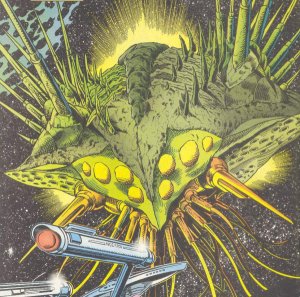
Ngultor Ship (EV MVL #1)
The Ngultor originate from a distant part of space. They believe that “the blending of the flesh — the cohesion of species into species — life into life — achieving a single union of wholeness, is a blessed state to be striven for.” The Ngultor vessels encountered by the U.S.S. Enterprise were stranded in Federation space by a warp drive malfunction. They captured several ships for spare parts from the crews before attempting to do the same with the Enterprise. They planned to send harvester vessels to Federation worlds following their return to their home territory, forcing Captain Pike to destroy them.[1]
References
Ngultor Mothership
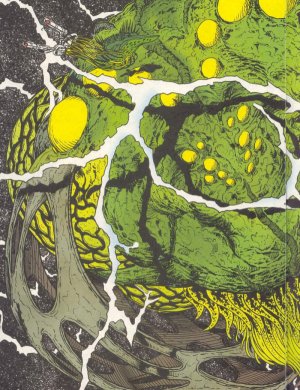
Ngultor Mothership (EV MVL #1)
The Ngultor originate from a distant part of space. They believe that “the blending of the flesh — the cohesion of species into species — life into life — achieving a single union of wholeness, is a blessed state to be striven for.” The Ngultor vessels encountered by the U.S.S. Enterprise were stranded in Federation space by a warp drive malfunction. They captured several ships for spare parts from the crews before attempting to do the same with the Enterprise. They planned to send harvester vessels to Federation worlds following their return to their home territory, forcing Captain Pike to destroy them.[1]
References
Miranda class
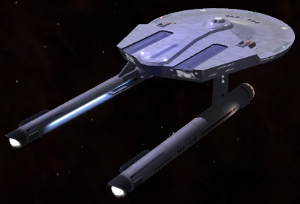
Miranda class (Legacy)
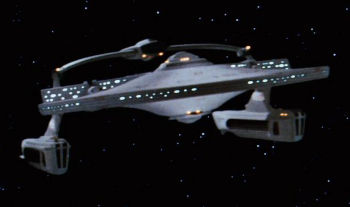
Miranda class (ST-02)
A Starfleet fixture of long-range scientific, supply, and exploratory missions for more than a century, Miranda class vessels probably logged more parsecs than any other single Federation vesel class. During the 23rd century, Starfleet Command placed an increasing emphasis on deep space exploration and surveying. The first ships launched after the inception of the exploratory vessel initiative, Miranda class vessels represent the most notable result of Starfleet’s renewed focus on exploration and discovery.[30] First commissioned during the period known as “The Great Awakening,” the Miranda class cruiser was in the forefront of that expansion effort. At the time, Starfleet itself was expanding in response to the changing and expanding economic and political goals of the Federation. To meet the demand of a larger navy, the Military Appropriations Committee authorized the development and testing of hundreds of vessel types, the Miranda among them.[6]
During this same period, the concepts of ship design were rapidly evolving and becoming more sophisticated, and the technology to build and operate starships was going through a revolution. Advances in all facets of the technology required to construct, maintain, and operate a starship were changing so rapidly that some ships were obsolete before they were completed. The Miranda design was changed no fewer than twelve times before the tooling and machining was begun. When these new cruisers were launched, they were only capable of performing three-year missions with resupply at one-year intervals. This made their dual-purpose role of research cruiser harder to perform. With the great distances that had to be travelled, they could not get more than six months travel time from a friendly outpost. This meant they could only advance as fast as the frontier was expanding. The class required some alterations during its trials and was to see many more changes after its commissioning, the last of which was a major refitting in the 2270s similar to that of the Constitution class.[6] Merging a host of diverse capabilities, versatility quickly became a hallmark of the class. Although Miranda class ships would primarily undertake scientific and exploratory missions, certain systems modules were swappable. These Miranda variants enjoyed great popularity in the early 24th century, and their expanded tactical and defensive systems were more than a match for most foes. Ships of this class participated in every major battle of the 24th century, often serving on the secondary or reserve battle lines.[30]
By the middle of the 24th century, Starfleet recommissioned many Miranda class vessels and sent them to surplus depots, scrapped them for parts, or used them as training vessels. Federation member planets and allied systems such as Altair and Betelgeuse first began to add reconditioned Miranda class ships to their own space fleets by the 2360s, after the active production life of these ships ceased. Hence, many Miranda class vessels continued to serve with distinction throughout Federation space and beyond for decades after their theoretical obsolescence.[30]
› Continue reading
S.S. Columbia
Civilian vessel that crashed on planet Talos IV during a survey expedition in 2236, eighteen years before the arrival of the U.S.S. Enterprise NCC-1701[1] in 2254.[2] Only one person aboard, Vina, survived the crash.[1]
References
U.S.S. Enterprise NCC-1701
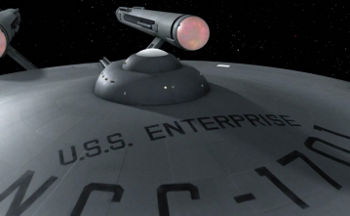
U.S.S. Enterprise (TOS-61)
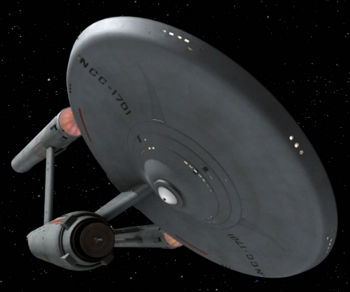
Constitution class (TOS-10)
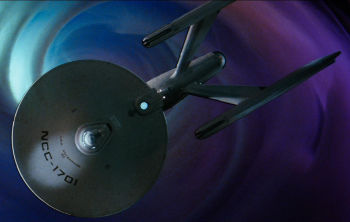
U.S.S. Enterprise (ST-2)
Perhaps the most famous spacecraft in the history of space exploration, the U.S.S. Enterprise NCC-1701 was a Constitution class vessel.[3] Launched in 2245[13] from the San Francisco Fleet Yards orbiting Earth,[1] the Enterprise was first commanded by Captain Robert April,[4] who was later succeeded by his first officer, Christopher Pike, in 2250.[9] During Pike’s command, the Enterprise had a crew complement of 203, though it was unclear if this figure included Pike himself.[1] According to Ensign Tyler, the ship’s power was “enough to blast half a continent.”[1] Superbly equipped for research in deep space, the Enterprise had 14 science labs.[2] The ship achieved legendary status during the first five-year mission under its third captain, James T. Kirk, from 2265 to 2270.[5]
› Continue reading
Constitution Class
Original Configuration

Constitution class (TOS-10)
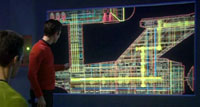
Constitution class MSD (ENT-95)
| Length | 289 meters |
| Width | 127 meters |
| Height | 73 meters |
| Decks | 23 |
| Mass | Mk. I: 162,425 metric tons Mk. II: 164,400 metric tons Mk. III: 167,900 metric tons |
| Crew Complement | 430 |
| Evacuation Limit | 320 |
| First Commissioned | 2245 |
| Weapons | 6 Type-V phaser banks, 2 torpedo launchers, photon torpedoes |
| Defenses | Deflector shields |
| Cruising Speed | Warp 6 |
| Maximum Cruise Speed | Warp 7 |
| Maximum Rated Speed | Warp 8 for 12 hours |
Refit Configuration
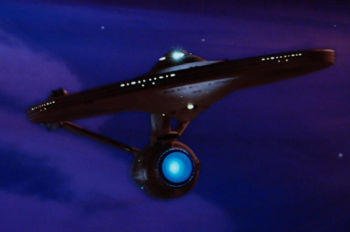
Constitution class refit (ST-02)
| Length | 305 meters |
| Width | 131 meters |
| Height | 74 meters |
| Crew Complement | 416 |
| Evacuation Limit | 240 |
| First Commissioned | 2273 |
| Weapons | 12 Type-VI phasers in 6 banks; 3 torpedo launchers, photon torpedoes |
| Defenses | Deflector shields |
| Cruising Speed | Warp 6 |
| Maximum Cruise Speed | Warp 8 |
| Maximum Rated Speed | Warp 10 for 12 hours |
The Constitution class cruisers are among the most renowned vessels of their time. Serving as both a research vessel and a cruiser, these ships performed their duties to perfection for the majority of the 23rd century. The Constitution class ships were an integral part of the buildup during “The Great Awakening,” from the outset the most versatile of all ships built for the expansion efforts. class starships included the acclaimed U.S.S. Enterprise NCC-1701.[1] During the time of Captain James T. Kirk’s celebrated first five-year mission of exploration, only twelve of these ships were in existence.[2] Constitution class starships used duotronic computers, based on designs developed by Dr. Richard Daystrom in 2243.[8]
› Continue reading
Vulcan
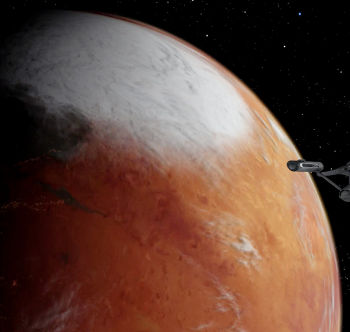
Vulcan (TOS-34)
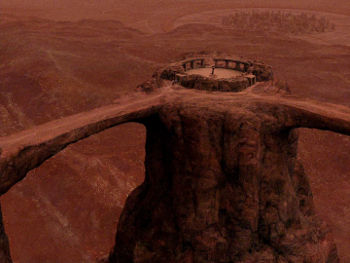
Vulcan surface (TOS-34)
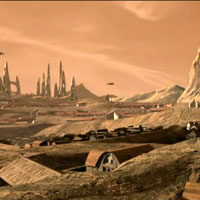
Vulcan surface (ENT-79)
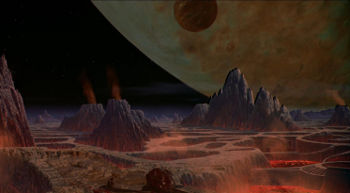
Vulcan Surface (ST-01)
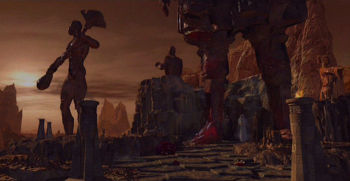
Vulcan Surface (ST-01)
Vulcan, a Class-M world,[2, 4] was the second planet in the 40 Eridani trinary system, orbiting 40 Eridani A.[4] Although Vulcan had no moon,[1] the planet shared an orbit with its sister world, T’Khut.[3]
› Continue reading
Venus
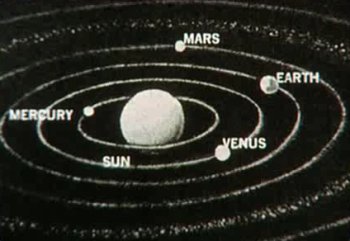
Sol System (TOS-00)
Venus, a Class-N world,[3] was the second planet in the Sol System.[1] Venus was 12,104 kilometers in diameter and had a gravity of 0.9 g, with a rotation of 243 Earth days and a surface temperature of 465°C. Venus was located 108 million kilometers from Sol, and took 224.7 days to complete one revolution around the star. Venus had no moons,[3] but was home to the Aphrodite Terraforming Station.[2] The Talosians viewed an image of the Sol System while accessing the U.S.S. Enterprise NCC-1701‘s computer.[1]
References
Vega Colony
Federation colony located in the Alpha Quadrant, approximately 24 light years from Earth. Space boomer Travis Mayweather was born on the cargo ship E.C.S. Horizon halfway between Vega Colony and the planet Draylax.[2] The Vega Colony was the destination of the U.S.S. Enterprise NCC-1701 following an incident on Rigel VII[1] in 2254.[3]
References
Categories
- Animated Series (60)
- Articles (28)
- Books (447)
- Cast & Crew (79)
- Comics (22)
- DS9 (328)
- Early Voyages (125)
- Education (5)
- Enterprise (373)
- Excelsior (36)
- Food (19)
- Games (223)
- Klingon (70)
- Library (1,543)
- Logs (593)
- Lost Era (55)
- Medicine (18)
- Merrimac (1)
- Mirror (35)
- Miscellaneous (13)
- New Frontier (54)
- Next Generation (635)
- Original Series (681)
- Personnel (436)
- Places (369)
- Politics (12)
- Recreation (10)
- SCE (41)
- Science (1)
- Shatnerverse (9)
- Ships (455)
- Site Updates (98)
- Starfleet Academy (86)
- Stargazer (42)
- STO (61)
- Technology (45)
- Titan (59)
- To Boldly Go (1)
- TV/Film (214)
- Uncategorized (4)
- Vanguard (76)
- Voyager (236)
- Weapons (27)
- Xenology (54)